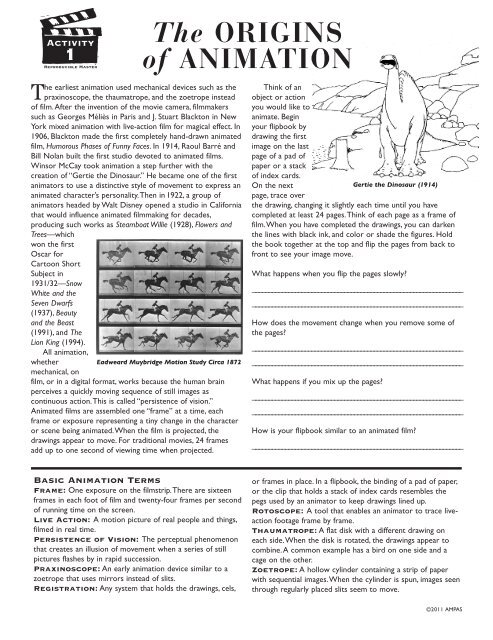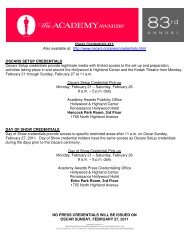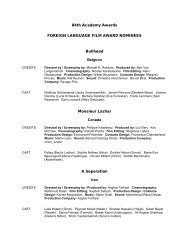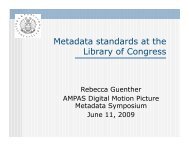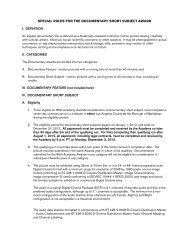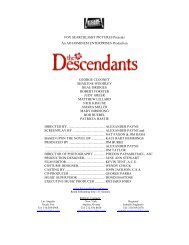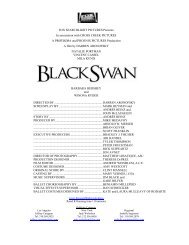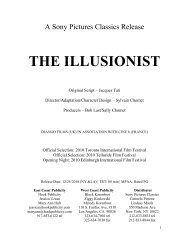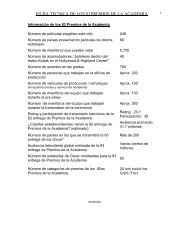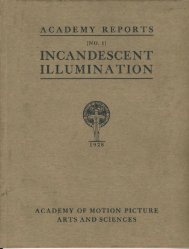CREATING MOVEMENT FRAME by FRAME - Academy of Motion ...
CREATING MOVEMENT FRAME by FRAME - Academy of Motion ...
CREATING MOVEMENT FRAME by FRAME - Academy of Motion ...
You also want an ePaper? Increase the reach of your titles
YUMPU automatically turns print PDFs into web optimized ePapers that Google loves.
Activity<br />
1<br />
Reproducible Master<br />
The earliest animation used mechanical devices such as the<br />
praxinoscope, the thaumatrope, and the zoetrope instead<br />
<strong>of</strong> film.After the invention <strong>of</strong> the movie camera, filmmakers<br />
such as Georges Méliès in Paris and J. Stuart Blackton in New<br />
York mixed animation with live-action film for magical effect. In<br />
1906, Blackton made the first completely hand-drawn animated<br />
film, Humorous Phases <strong>of</strong> Funny Faces. In 1914, Raoul Barré and<br />
Bill Nolan built the first studio devoted to animated films.<br />
Winsor McCay took animation a step further with the<br />
creation <strong>of</strong> “Gertie the Dinosaur.” He became one <strong>of</strong> the first<br />
animators to use a distinctive style <strong>of</strong> movement to express an<br />
animated character’s personality.Then in 1922, a group <strong>of</strong><br />
animators headed <strong>by</strong> Walt Disney opened a studio in California<br />
that would influence animated filmmaking for decades,<br />
producing such works as Steamboat Willie (1928), Flowers and<br />
Trees—which<br />
won the first<br />
Oscar for<br />
Cartoon Short<br />
Subject in<br />
1931/32—Snow<br />
White and the<br />
Seven Dwarfs<br />
(1937), Beauty<br />
and the Beast<br />
(1991), and The<br />
Lion King (1994).<br />
All animation,<br />
whether<br />
Eadweard Muybridge <strong>Motion</strong> Study Circa 1872<br />
mechanical, on<br />
film, or in a digital format, works because the human brain<br />
perceives a quickly moving sequence <strong>of</strong> still images as<br />
continuous action.This is called “persistence <strong>of</strong> vision.”<br />
Animated films are assembled one “frame” at a time, each<br />
frame or exposure representing a tiny change in the character<br />
or scene being animated.When the film is projected, the<br />
drawings appear to move. For traditional movies, 24 frames<br />
add up to one second <strong>of</strong> viewing time when projected.<br />
Basic Animation Terms<br />
Frame: One exposure on the filmstrip.There are sixteen<br />
frames in each foot <strong>of</strong> film and twenty-four frames per second<br />
<strong>of</strong> running time on the screen.<br />
Live Action: A motion picture <strong>of</strong> real people and things,<br />
filmed in real time.<br />
Persistence <strong>of</strong> Vision: The perceptual phenomenon<br />
that creates an illusion <strong>of</strong> movement when a series <strong>of</strong> still<br />
pictures flashes <strong>by</strong> in rapid succession.<br />
Praxinoscope: An early animation device similar to a<br />
zoetrope that uses mirrors instead <strong>of</strong> slits.<br />
Registration: Any system that holds the drawings, cels,<br />
The ORIGINS<br />
<strong>of</strong> ANIMATION<br />
Think <strong>of</strong> an<br />
object or action<br />
you would like to<br />
animate. Begin<br />
your flipbook <strong>by</strong><br />
drawing the first<br />
image on the last<br />
page <strong>of</strong> a pad <strong>of</strong><br />
paper or a stack<br />
<strong>of</strong> index cards.<br />
On the next<br />
Gertie the Dinosaur (1914)<br />
page, trace over<br />
the drawing, changing it slightly each time until you have<br />
completed at least 24 pages.Think <strong>of</strong> each page as a frame <strong>of</strong><br />
film.When you have completed the drawings, you can darken<br />
the lines with black ink, and color or shade the figures. Hold<br />
the book together at the top and flip the pages from back to<br />
front to see your image move.<br />
What happens when you flip the pages slowly?<br />
________________________________________________________________<br />
________________________________________________________________<br />
How does the movement change when you remove some <strong>of</strong><br />
the pages?<br />
________________________________________________________________<br />
________________________________________________________________<br />
What happens if you mix up the pages?<br />
________________________________________________________________<br />
________________________________________________________________<br />
How is your flipbook similar to an animated film?<br />
________________________________________________________________<br />
or frames in place. In a flipbook, the binding <strong>of</strong> a pad <strong>of</strong> paper,<br />
or the clip that holds a stack <strong>of</strong> index cards resembles the<br />
pegs used <strong>by</strong> an animator to keep drawings lined up.<br />
Rotoscope: A tool that enables an animator to trace liveaction<br />
footage frame <strong>by</strong> frame.<br />
Thaumatrope: A flat disk with a different drawing on<br />
each side.When the disk is rotated, the drawings appear to<br />
combine.A common example has a bird on one side and a<br />
cage on the other.<br />
Zoetrope: A hollow cylinder containing a strip <strong>of</strong> paper<br />
with sequential images.When the cylinder is spun, images seen<br />
through regularly placed slits seem to move.<br />
©2011 AMPAS


